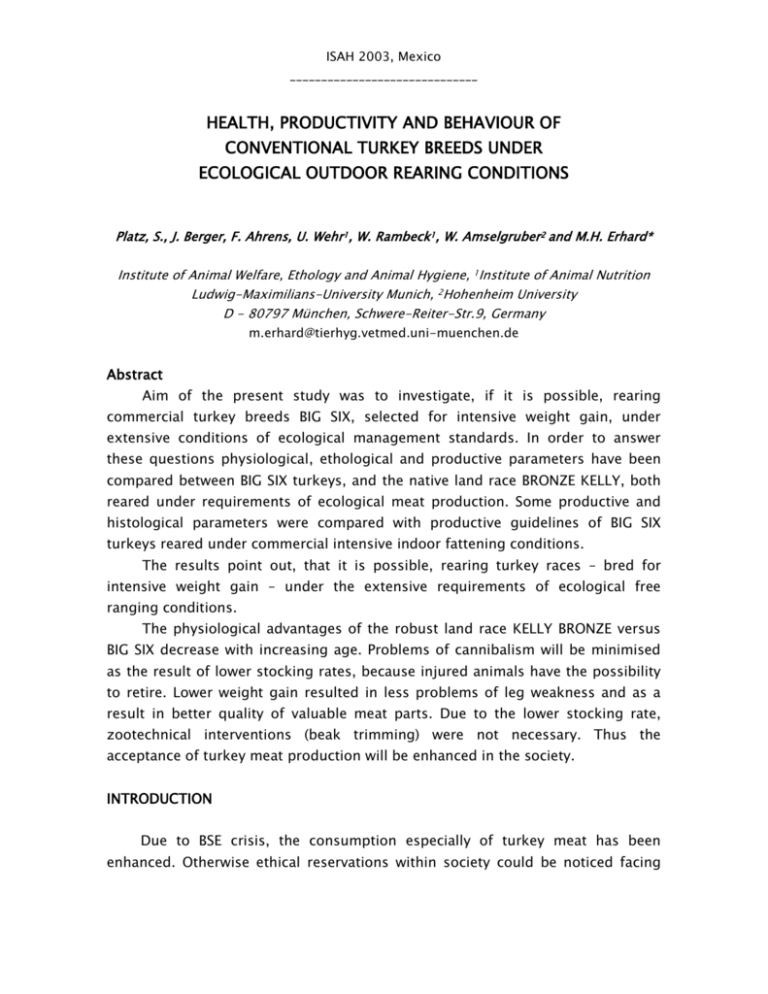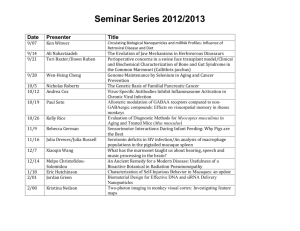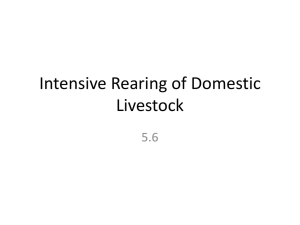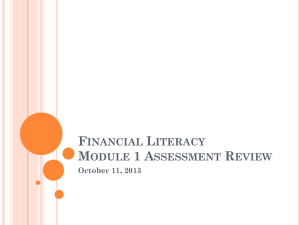health, productivity and behaviour of conventional turkey breeds
advertisement

ISAH 2003, Mexico ______________________________ HEALTH, PRODUCTIVITY AND BEHAVIOUR OF CONVENTIONAL TURKEY BREEDS UNDER ECOLOGICAL OUTDOOR REARING CONDITIONS Platz, S., J. Berger, F. Ahrens, U. Wehr1, W. Rambeck1, W. Amselgruber2 and M.H. Erhard* Institute of Animal Welfare, Ethology and Animal Hygiene, 1Institute of Animal Nutrition Ludwig-Maximilians-University Munich, 2Hohenheim University D - 80797 München, Schwere-Reiter-Str.9, Germany m.erhard@tierhyg.vetmed.uni-muenchen.de Abstract Aim of the present study was to investigate, if it is possible, rearing commercial turkey breeds BIG SIX, selected for intensive weight gain, under extensive conditions of ecological management standards. In order to answer these questions physiological, ethological and productive parameters have been compared between BIG SIX turkeys, and the native land race BRONZE KELLY, both reared under requirements of ecological meat production. Some productive and histological parameters were compared with productive guidelines of BIG SIX turkeys reared under commercial intensive indoor fattening conditions. The results point out, that it is possible, rearing turkey races – bred for intensive weight gain – under the extensive requirements of ecological free ranging conditions. The physiological advantages of the robust land race KELLY BRONZE versus BIG SIX decrease with increasing age. Problems of cannibalism will be minimised as the result of lower stocking rates, because injured animals have the possibility to retire. Lower weight gain resulted in less problems of leg weakness and as a result in better quality of valuable meat parts. Due to the lower stocking rate, zootechnical interventions (beak trimming) were not necessary. Thus the acceptance of turkey meat production will be enhanced in the society. INTRODUCTION Due to BSE crisis, the consumption especially of turkey meat has been enhanced. Otherwise ethical reservations within society could be noticed facing ISAH 2003, Mexico ______________________________ the intensity of turkey meat production with the well known problems regarding health and animal welfare, caused by intensive weight gain and stocking rate. One possibility of solving these conflicts is the ecological way of animal production under extensive free ranging conditions and minimised stocking rates. To meet these requirements, basic standards of ecological way of management in animal production are fixed in the ordinance 2092/91 EWG. It contains essential elements for a pro-animal and environmentally acceptable form of farm animal husbandry. The most important points of these standards are : Selection of robust farm animal races with optimal adaptability to the demanded outdoor rearing conditions no zootechnical manipulation of the animals like beak trimming etc., outdoor free ranging husbandry-conditions, food, harvested from the own farm and produced by ecological standards, without any additives and animal protein impurities. ISAH 2003, Mexico ______________________________ With regard to turkeys, only few races, which approximate these demands are available with about 1% market share. Therefore it has been investigated, if it is possible, rearing commercial turkey breeds BIG SIX, selected for intensive weight gain, under extensive conditions of ecological management standards. MATERIAL AND METHODS In order to answer the questions mentioned above, physiological, ethological and productive parameters have been compared between BIG SIX turkeys, and Bronze Kelly turkeys, both reared under requirements of ecological meat production. The latter are turkeys of a native land race, well adapted to outdoor keeping conditions. Some productive and histological parameters were compared with productive guidelines of BIG SIX turkeys reared under commercial intensive indoor fattening conditions. Each group consists of 200 animals and has been reared consequently separated under identical conditions during the overall experiment. For 8 weeks, the turkeys have been raised in conditioned rearing pens, afterwards they were on pasture until the date of slaughtering at 23 weeks of life. At an interval of 4 weeks blood samples have been taken from 15 animals, randomly selected, of each group. The blood samples were tested on haemoglobin, haematocrit and immunoglobulin Y. The weight gain pattern was controlled weekly from 10 animals of each group, likewise randomly selected. To estimate the degree of well-being, different features of behaviour were observed by long term videotaping and by daily direct observations. Further on, the state of health was controlled by the rate of diseases and losses as well as clinical observations. Post slaughtering parameters were recorded by comparative slaughter studies (15 animals each group), histological evaluation of breast-muscle fibre (M. supracoracoideus) as well as calcification and tensile strength of the femur (3 animals each group and 3 BIG SIX, kept under intensive fattening conditions). RESULTS AND DISCUSSION Ethological Investigations ISAH 2003, Mexico ______________________________ There were no apparent differences of the different features of behaviour between the two breeds. Especially the natural rearing conditions on the pasture enabled normal behaviour patterns of the turkeys. Regarding social behaviour BIG SIX chicken showed a higher rate of aggressive conflicts, due to the minimised base/animal in the rearing pens in consequence of increasing body weight. In case of aggressive conflicts the white coloured BIG SIX are much more conspicuous after bleeding injuries than the black coloured KELLY BRONZE turkeys. This may be the cause of higher incidence of losses by cannibalism regarding BIG SIX (12) compared with KELLY BRONZE (4). Therefore it is of high importance, that injured animals (especially the white BIG SIX) have the possibility to retire. Under the conditions of free range keeping with the lower stocking rates, these possibilities are given. Hence the grazing period with lower stocking rate resulted in less social conflicts in each group and no signs of cannibalism could be observed, though the animals were not beak trimmed. ISAH 2003, Mexico ______________________________ Morbidity, Mortality and Weight gain During the whole study, 46 BIG SIX and 65 KELLY BRONZE died. These high losses were caused mainly by two consecutive following infections (Clostridium, E. coli) during the breeding period in the first weeks. However, these losses seems not to be relevant to the actual question, because rearing conditions do not differ between ecological and conventional turkey meat production in the breeding period. It is remarkable, that losses during the period of free range keeping have been confined to 6 animals in each group. The causes of losses during the grazing period were fractures, strangulation by straw bands and stunting. About the end of grazing period, sporadic signs of leg weakness could be observed. Therefrom 5.2% KELLY BRONZE and 3.2% BIG SIX were concerned. However, the development of breast bladders was not detectable. In comparison with the guidelines for weight gain of BIG SIX, kept under intensive fattening conditions, extensive reared BIG SIX achieved about 80% and KELLY BRONZE about 70 % of the body weight at the age of 23 weeks (Fig.1). Fig. 1 : Weight gain as from 7th week of age (n = 15/weighthings/group) * productive guidelines for intensive fattening body weight (g) 25000 Kelly 20000 BigSix extensive 15000 BigSix intensive * 10000 5000 0 7 8 9 10 11 12 13 14 15 16 17 18 19 20 21 22 week of fattening In the present study, the cause of these results seems – especially with regard to BIG SIX extensive - to be founded mainly in the infections during the raising period mentioned above and the resulting worse weight development. ISAH 2003, Mexico ______________________________ Concerning KELLY BRONZE furthermore the reduced “genetic growth potential” of this breed will be a cause of the lower weight gain. Physiological Parameters Partly significant differences between BIG SIX and KELLY BRONZE could be found in haematocrit (Fig. 2) and immunoglobulin Y concentrations (Fig. 3) during the first 4 and 8 weeks of life with higher concentrations of KELLY BRONZE. Both breeds tends to an increase of haematocrit overall the period of life. Likewise immunoglobulin Y concentration showed increasing tendency overall the lifetime of both breeds with a plateau of concentration between 12th and 16th week of age. This could be interpreted as an adaptative reaction to the conditions of free ranging. Haematocrit *: P < 0,05 Big Six Kelly 60 Percent 50 40 * * 4 8 30 20 10 0 12 Age [weeks] 16 20 ISAH 2003, Mexico ______________________________ Average concentration of serum Ig Y 18 *: P < 0,10 Big Six Kelly 16 14 mg/ml 12 10 * 8 6 4 * 2 0 4 8 12 16 20 23 Age [weeks] Regarding to haemoglobin no difference between the two breeds could be found. The concentration of haemoglobin ranged between 10 to 12 mg/dl during the time of investigation Looking to bone physiological parameters KELLY BRONZE showed higher Ca– concentration in the serum. Until the age of 12 weeks, these differences are significant. In contrast the results concerning the concentration of phosphorus in serum are inconsistent. It is an conspicuous fact, that the tested physiological parameters approximate between the two turkey breeds with increasing age. Generally the Ca/P ratio of both breeds lay in the physiological range between 1:1 to 2:1. Fig. 4: Ca & P concentration in serum of Kelly vs. BIG SIX Age KELLY KELLY BIG SIX BIG SIX in weeks Ca P Ca P 4 10,8 ± 0,001 8,44 ± 0,27 10,0* ± 0,001 8,2 ± 0,22 8 12,8 ± 0,001 13,54 ± 0,62 10,9* ± 0,002 10,2# ± 0,57 12 11,4 ± 0,001 8,86 ± 0,26 10,5* ± 0,002 7,9# ± 0,27 16 11,1 ± 0,002 7,23 ± 0,29 11,0 ± 0,001 8,3# ± 0,13 20 11,8 ± 0,005 6,21 ± 0,43 11,4 ± 0,003 6,6 ± 0,26 23 11,7 ± 0,005 8,21 ± 0,89 10,7 ± 0,003 7,8 ± 0,22 ISAH 2003, Mexico ______________________________ * p < 0,05 (serum - Ca - concentration); n = 5/section of age # p < 0,05 (serum - P - concentration); n = 5/section of age Post mortem analysis To evaluate the carcase, a detailed dissection was carred out. The percentage of the single carcase joints, based on the total carcase is shown in Fig 5. Fig. 5 : percentage of single carcase joints based on total carcase (n = 15) % 40 Kelly 35 BigSix extensive 30 25 20 BigSix intensive* *productive guidelines for intensive fattening 15 10 5 0 total wing total topside total lower leg breast with skin Compared with the guidelines of intensive reared BIG SIX extensive free ranging resulted in less carcase dressing percentage of valuable parts of meat. This is evident especially regarding the breast muscle, which has the full attention of commercial turkey breeders, because of its high value. Under the conditions of extensive free ranging, both breeds show no fundamental differences with slight higher percentages in favour of KELLY BRONZE. Obvious variations between the different breeds could be stated by the histological analysis of muscle fibres of M. supracoricoideus. KELLY BRONZE showed the highest diameter of the fibres, which can be interpreted as a relative exhaustion of the “growth potential” of this breed with lower end weights. In contrast, the extensive reared BIG SIX showed the smallest diameter as a result of ISAH 2003, Mexico ______________________________ lower weight gain pattern due to ecological rearing conditions. The diameter of intensive reared BIG SIX took a medial position.









